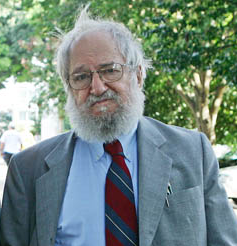|
Papert
Seymour Aubrey Papert (; 29 February 1928 – 31 July 2016) was a South African-born American mathematician, computer scientist, and educator, who spent most of his career teaching and researching at MIT. He was one of the pioneers of artificial intelligence, and of the constructionist movement in education. He was co-inventor, with Wally Feurzeig and Cynthia Solomon, of the Logo programming language. Early years and education Born to a Jewish family,Remembering Seymour Papert: Revolutionary Socialist and Father of A.I. Benjamin Ivry, 3 August 2016 Papert attended the |
Perceptrons (book)
''Perceptrons: an introduction to computational geometry'' is a book written by Marvin Minsky and Seymour Papert and published in 1969. An edition with handwritten corrections and additions was released in the early 1970s. An expanded edition was further published in 1987, containing a chapter dedicated to counter the criticisms made of it in the 1980s. The main subject of the book is the perceptron, a type of artificial neural network developed in the late 1950s and early 1960s. The book was dedicated to psychologist Frank Rosenblatt, who in 1957 had published the first model of a "Perceptron". Rosenblatt and Minsky knew each other since adolescence, having studied with a one-year difference at the Bronx High School of Science. They became at one point central figures of a debate inside the AI research community, and are known to have promoted loud discussions in conferences, yet remained friendly. This book is the center of a long-standing controversy in the study of artificial ... [...More Info...] [...Related Items...] OR: [Wikipedia] [Google] [Baidu] |
Constructionism (learning Theory)
Constructionist learning is the creation by learners of mental models to understand the world around them. Constructionism advocates student-centered, discovery learning where students use what they already know, to acquire more knowledge.Alesandrini, K. & Larson, L. (2002). Teachers bridge to constructivism. The Clearing House, 119–121. Students learn through participation in project-based learning where they make connections between different ideas and areas of knowledge facilitated by the teacher through coaching rather than using lectures or step-by-step guidance. Further, constructionism holds that learning can happen most effectively when people are active in making tangible objects in the real world. In this sense, constructionism is connected with experiential learning and builds on Jean Piaget's epistemological theory of constructivism. Seymour Papert defined constructionism in a proposal to the National Science Foundation titled ''Constructionism: A New Opportunity ... [...More Info...] [...Related Items...] OR: [Wikipedia] [Google] [Baidu] |
Logo Programming Language
Logo is an educational programming language, designed in 1967 by Wally Feurzeig, Seymour Papert, and Cynthia Solomon. ''Logo'' is not an acronym: the name was coined by Feurzeig while he was at Bolt, Beranek and Newman, and derives from the Greek ''logos'', meaning ''word'' or ''thought''. A general-purpose language, Logo is widely known for its use of turtle graphics, in which commands for movement and drawing produced line or vector graphics, either on screen or with a small robot termed a turtle. The language was conceived to teach concepts of programming related to Lisp and only later to enable what Papert called " body-syntonic reasoning", where students could understand, predict, and reason about the turtle's motion by imagining what they would do if they were the turtle. There are substantial differences among the many dialects of Logo, and the situation is confused by the regular appearance of turtle graphics programs that are named Logo. Logo is a multi-paradigm adaptat ... [...More Info...] [...Related Items...] OR: [Wikipedia] [Google] [Baidu] |
Sherry Turkle
Sherry Turkle (born June 18, 1948) is the Abby Rockefeller Mauzé Professor of the Social Studies of Science and Technology at the Massachusetts Institute of Technology. She obtained an BA in social studies and later a PhD in sociology and personality psychology at Harvard University. She now focuses her research on psychoanalysis and human-technology interaction. She has written several books focusing on the psychology of human relationships with technology, especially in the realm of how people relate to computational objects. Her latest book 'Empathy Diaries' her memoir received fair critical reviews. Writings In ''The Second Self'', she writes about how computers are not tools as much as they are a part of our social and psychological lives, writing that technology "catalyzes changes not only in what we do but in how we think.” She goes on using Jean Piaget's psychology discourse to discuss how children learn about computers and how this affects their minds. ''The Second ... [...More Info...] [...Related Items...] OR: [Wikipedia] [Google] [Baidu] |
Papert's Principle
In child psychology, Papert's principle is often used to explain the results of Jean Piaget's experiments. It is named for Seymour Papert and states that: See also * Association *Attention * Dissociation *Child development * Developmental psychology *Language development * Mental development *Thought In their most common sense, the terms thought and thinking refer to conscious cognitive processes that can happen independently of sensory stimulation. Their most paradigmatic forms are judging, reasoning, concept formation, problem solving, an ... References External links * * Developmental psychology {{developmental-psych-stub ... [...More Info...] [...Related Items...] OR: [Wikipedia] [Google] [Baidu] |
Dona Strauss
Dona Anschel Papert Strauss (born April 1934) is a South African mathematician working in topology and functional analysis. Her doctoral thesis was one of the initial sources of pointless topology. She has also been active in the political left, lost one of her faculty positions over her protests of the Vietnam War, and became a founder of European Women in Mathematics. Mathematician Neil Hindman, with whom Strauss wrote a book on the Stone–Čech compactification of topological semigroups, has stated the following as advice for other mathematicians: "Find someone who is smarter than you are and get them to put your name on their papers", writing that for him, that someone was Dona Strauss. Education and career Strauss is originally from South Africa, the descendant of Jewish immigrants from Eastern Europe. Her father was a physicist at the University of Cape Town. She grew up in the Eastern Cape, and earned a master's degree in mathematics at the University of Cape Town. Sh ... [...More Info...] [...Related Items...] OR: [Wikipedia] [Google] [Baidu] |
Idit Harel Caperton
Idit R. Harel (born Idit Ron; September 18, 1958) is an Israeli-American entrepreneur and CEO of Globaloria. She is a learning sciences researcher and pioneer of Constructionist learning-based EdTech interventions. Overview Harel researches and writes on the impact of computational new media technology on the social and academic development of children and their epistemology. Her MIT Media Lab research with Seymour Papert has contributed to the development of constructionist learning theory. She blogs monthly on Huffington Post Impact and Technology verticals on computer skills education, particularly for young women, girls, and underprivileged children, and the value of massive open online courses (MOOCs) in education reform. Harel was the founder and CEO of MaMaMedia Inc., the executive director of the MaMaMedia Consulting Group (MCG), and the founder, President, and Chair of thWorld Wide Workshop educational technology development companies. She is presently the CEO and a foun ... [...More Info...] [...Related Items...] OR: [Wikipedia] [Google] [Baidu] |
Carl Hewitt
Carl Eddie Hewitt () is an American computer scientist who designed the Planner programming language for automated planningCarl Hewitt''PLANNER: A Language for Proving Theorems in Robots''IJCAI. 1969. and the actor model of concurrent computation, which have been influential in the development of logic, functional and object-oriented programming. Planner was the first programming language based on procedural plans invoked using pattern-directed invocation from assertions and goals. The actor model influenced the development of the Scheme programming language, the π-calculus, and served as an inspiration for several other programming languages. Education and career Hewitt obtained his PhD in mathematics at MIT in 1971, under the supervision of Seymour Papert, Marvin Minsky, and Mike Paterson. He began his employment at MIT that year, and retired from the faculty of the MIT Department of Electrical Engineering and Computer Science during the 1999–2000 school year. He became e ... [...More Info...] [...Related Items...] OR: [Wikipedia] [Google] [Baidu] |
David Williamson Shaffer
David Williamson Shaffer (born May 10, 1964 in New York City, NY) is the Vilas Distinguished Achievement Professor of Learning Science at the University of Wisconsin–Madison in the department of Educational Psychology, the Obel Foundation Professor of Learning Analytics at Aalborg University in Copenhagen, a Data Philosopher at the Wisconsin Center for Education Research, and Principal of EFGames, LLC. Education and career Shaffer received an A.B. in History and East Asian Studies (1987) from Harvard University and his M.S. (1996) and Ph.D. (1998) in Media Arts and Sciences from MIT. Shaffer was a student of James J. Kaput, Mitchel Resnick, William J. Mitchell and Seymour Papert, who studied with Jean Piaget. Shaffer began his career as a teacher at The Mountain School, an independent school in Vershire, VT. He taught and worked as a teacher-trainer in the US Peace Corps in Nepal from 1989–1991 in a secondary-level science and math teacher development program sponsored by the ... [...More Info...] [...Related Items...] OR: [Wikipedia] [Google] [Baidu] |
Gerald Jay Sussman
Gerald Jay Sussman (born February 8, 1947) is the Panasonic Professor of Electrical Engineering at the Massachusetts Institute of Technology (MIT). He received his S.B. and Ph.D. degrees in mathematics from MIT in 1968 and 1973 respectively. He has been involved in artificial intelligence (AI) research at MIT since 1964. His research has centered on understanding the problem-solving strategies used by scientists and engineers, with the goals of automating parts of the process and formalizing it to provide more effective methods of science and engineering education. Sussman has also worked in computer languages, in computer architecture and in Very Large Scale Integration (VLSI) design. Education Sussman attended the Massachusetts Institute of Technology as an undergraduate and received his S.B. in mathematics in 1968. He continued his studies at MIT and obtained a Ph.D. in 1973, also in mathematics, under the supervision of Seymour Papert. His doctoral thesis was titled "A ... [...More Info...] [...Related Items...] OR: [Wikipedia] [Google] [Baidu] |
Suzanne Massie
Suzanne Massie (née Rohrbach; born January 8, 1931) is an American scholar of Russian history who played an important role in the relations between Ronald Reagan and the Soviet Union in the final years of the Cold War. In mid-May 2021, she asked Russian President Vladimir Putin to grant her Russian citizenship. In an NTV broadcast, she previously said that the American media hate Russia. Biography Massie is the daughter of a Swiss diplomat. She was born in New York and graduated from Vassar College, but also studied at the Sorbonne and the Institute of Political Studies in Paris. In 1975, Suzanne Massie and her then-husband Robert K. Massie chronicled their experiences as the parents of a hemophiliac child, Robert Kinloch Massie IV, and the significant differences between the American and French health-care systems in their jointly written book, ''Journey.'' ''Journey'' followed her husband's 1967 book, ''Nicholas and Alexandra,'' a biography of the last Emperor and Empre ... [...More Info...] [...Related Items...] OR: [Wikipedia] [Google] [Baidu] |
Mitchel Resnick
Mitchel Resnick (born June 12, 1956) is Lego Papert Professor of Learning Research, Director of the Okawa Center, and Director of the Lifelong Kindergarten group at the Massachusetts Institute of Technology (MIT) Media Lab. , Resnick serves as head of the Media Arts and Sciences academic program, which program grants master's degrees and Ph.D.s at the MIT Media Lab. Resnick's research group has developed a variety of educational tools that engage people in new types of design activities and learning experiences, including the ''Programmable Bricks'' that were the basis for the award-winning Lego Mindstorms and StarLogo software. He cofounded the Computer Clubhouse, an award-winning network of learning centers for youth from under-served communities. Resnick is also a cofounder and a coprincipal investigator of the Center for Civic Media at MIT. Resnick's group has developed a new computer programming language, named Scratch, that makes it easier for children to create animat ... [...More Info...] [...Related Items...] OR: [Wikipedia] [Google] [Baidu] |




.jpg)